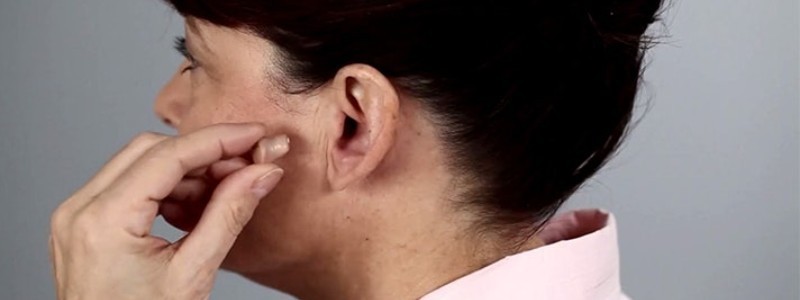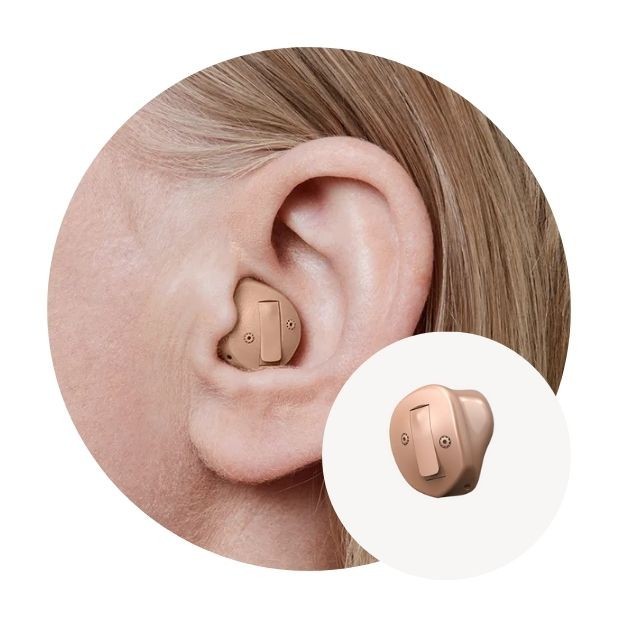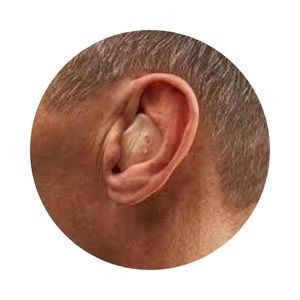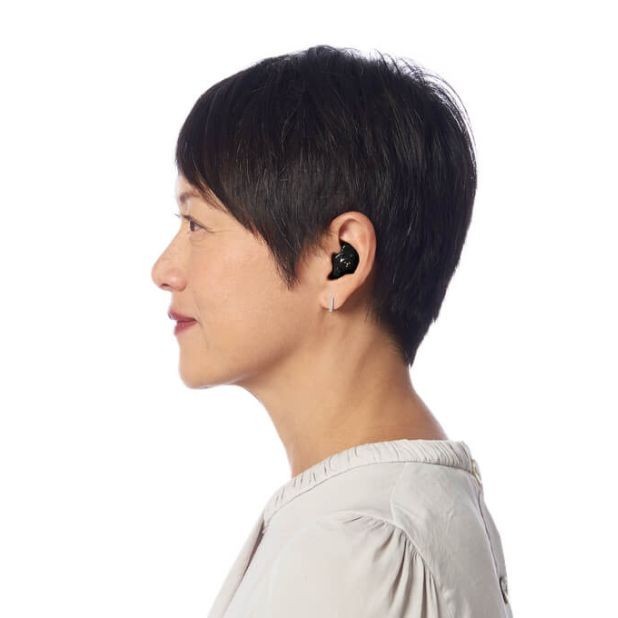Free home visits
with a local audiologist

In-the-Ear (ITE) hearing aids represent a discreet and customisable solution for individuals with hearing loss. These hearing devices are designed to fit snugly within the ear, making them less noticeable to others.
ITE hearing aids are custom-molded to fit the individual's ear canal or the outer ear, ensuring a comfortable and secure fit. This page is dedicated to going through all the aspects of ITE hearing aids and what you should expect from this type of device.

What is an In-the-ear hearing aid? Also sometimes referred to as Full Shell hearing aids or Custom hearing aids, In the Ear (ITE) hearing aids, are designed to fit snugly into the entire concha or bowl or your ear, with the entire workings of the hearing aid fitting inside its single casing.
They are custom-made to a mould of your ear and so are normally very comfortable to wear, and their larger size allows for the incorporation of more helpful technological features.
Also sometimes referred to as Full Shell hearing aids or custom hearing aids, In the Ear (ITE) hearing aids, are designed to fit snugly into the entire concha or bowl or your ear, with the entire workings of the hearing aid fitting inside its single casing.
They are custom-made to a mould of your ear and so are normally very comfortable to wear, and their larger size allows for the incorporation of more helpful technological features.
There has been a slight decline in the popularity of In the Ear (ITE) hearing aids over recent years, however, we think that they can still be a great choice for people who need higher levels of processing and amplification power, or who have dexterity issues or visual impairments.
This is because they are easy to fit and many of their functions and controls can be situated on the aid itself.
In the Ear (ITE) hearing aids have numerous different advantages and disadvantages. Our information below details some of the most common of these, however for more details please contact our expert team today and we’ll happily talk you through all of your options and book your free hearing test too.
Are there ITE Bluetooth hearing aids available? Despite their small size, ITE hearing aids offer advanced features such as directional microphones, Bluetooth connectivity, and noise reduction, enhancing the overall listening experience while maintaining a subtle appearance.
What is the difference between BTE and ITE hearing aids? Behind-the-Ear (BTE) and In-the-Ear (ITE) hearing aids differ in several key ways. BTE aids are worn behind the ear, connected by a thin tube or wire to an earmold or earpiece in the ear canal. They are suitable for various hearing loss levels, offer advanced features, and are more visible.
ITE hearing aids, on the other hand, are custom-molded to fit entirely inside the ear, making them nearly invisible. They suit mild to moderate hearing loss but have limited space for features. BTE aids are more durable, while ITE aids are discreet. The choice depends on hearing needs, cosmetic preferences, and lifestyle.
What are the differences between ITE and ITC hearing aids? In-the-Ear (ITE) and In-The-Canal (ITC) hearing aids share similarities with custom-molded solutions, but they have distinct differences. ITE aids are slightly larger, filling the outer ear, while ITC aids are smaller and fit partly into the ear canal. This size variation impacts visibility, with ITC aids being more discreet.
ITE aids are suitable for mild to severe hearing loss and can include features like directional microphones and volume controls. ITC aids are best for mild to moderate hearing loss but offer a cosmetically appealing option due to their subtler appearance. The choice depends on the degree of hearing loss and cosmetic preference.

Due to their larger size In the Ear (ITE), hearing aids can have more of their controls situated on the actual casing itself.
This means that many people find them much easier to use and control than smaller aids or those that come with external controllers or smartphone apps.
This means that they are especially suited to users with dexterity issues or visual impairments, and it also means that changing the battery is easier too.
Compared to BTE or RIC hearing aids where you have to hold a telephone slightly above or to the back of your ear, with In the Ear (ITE) hearing aids you can use the telephone just as you always have. This can be a real bonus for people for whom old habits die hard!
Because In the Ear (ITE) hearing aids are manufactured specifically for you from a custom mould of your ear they are extremely comfortable to wear.
As In the Ear (ITE) hearing aids are larger than some other types of In the Ear hearing aids they are able to include larger and more powerful amplifiers and processors and also in some models additional directional microphones.
This means that they are suitable for users with more severe levels of hearing loss.
Because of their larger size and the fact that they fit simply inside your ear, In the Ear (ITE) hearing aids are very easy to insert and remove.
Many people find that the smaller styles of In the Ear hearing aids (such as In The Canal (ITC) hearing aids, Completely In the Canal (CIC) hearing aids, and Invisible In the Canal (IIC) hearing aids) are too small and fiddly.
The two-piece design of Behind the Ear (BTE) and Open / Receiver In Canal (RIC) hearing aids can make them difficult to position correctly.
However because In the Ear (ITE) hearing aids are custom made to a mould of your ear it is simple to ensure that they are positioned perfectly.
This again makes In the Ear (ITE) hearing aids especially suitable for users with dexterity issues or visual impairments.
With no small and fiddly components In the Ear (ITE) hearing aids are often much easier to clean and maintain than some of the smaller styles of hearing aids.
Many users also find that accessing the battery compartment and changing the battery is much easier with In the Ear (ITE) hearing aids than with some other styles.

Even considering that In the Ear (ITE) hearing aids are one of the larger hearing aid styles available, you still have to remember that they are still small enough to fit inside your ear.
This means that generally, they are only able to take the smaller battery sizes and so may struggle to provide enough power to suit those with more severe levels of hearing loss, or if they do then the battery life may be much more limited.
If higher levels of power are an important feature for you then it may be worth considering a Behind the Ear (BTE) hearing aid.
Due to the position of In the Ear (ITE) hearing aids outside of the ear canal itself, it means that they can be vulnerable to picking up wind noise.
This can make it more difficult to hear properly when you are outside in windy conditions as the wind noise can be amplified more than the sounds that you actually want to hear.
However, hearing aid technology has advanced to the point where many In the Ear (ITE) hearing aids are able to detect, isolate, and reduce the sound of wind noise.
Because they are made from a custom mould of your ear, In the Ear (ITE) hearing aids can be more expensive than other styles of hearing aids that consist of standard parts.
However, if you buy your In the Ear (ITE) hearing aid from HearingAid.org.uk then you will pay the same price for your hearing aid regardless of the style you choose.
Occlusion is the result of your ear being completely filled by a hearing aid or other foreign body. It can cause symptoms such as; chewing food and swallowing sounding noisy and annoying, hearing your own voice louder than it should be, your voice having a hollow sound to it or the unpleasant feeling that your ear is blocked.
As In the Ear (ITE) hearing aids completely cover your ear canal, occlusion can be a side effect of wearing this type of hearing aid.
However many In the Ear (ITE) hearing aids actually feature clever little vents which are often able to alleviate occlusion all together.
Even though In the Ear (ITE) hearing aids are often available in a range of colours to match your skin tone, they are still one of the larger and more conspicuous styles of hearing aids.
However many users find that their ease of use more than makes up for someone being able to tell that they are wearing a hearing aid!

What are the brands that make In the Ear (ITE) hearing aids? Cost, lifestyle, and cosmetic concerns all factor into the decision-making process when selecting the most suitable hearing aid style.
Ultimately, a professional evaluation is crucial to determine the best fit for each individual's unique hearing profile. Click on the links below to discover each brand's ITE portfolio.
►Phonak In the Ear (ITE) hearing aids
►Oticon In the Ear (ITE) hearing aids
►Widex In the Ear (ITE) hearing aids
►Resound In the Ear (ITE) hearing aids
►Starkey In the Ear (ITE) hearing aids
►Signia In the Ear (ITE) hearing aids
To find out more about In the Ear (ITE) hearing aids, or any of the other types of hearing aids that are available, contact our advisors and let us help you find the right hearing aid today. Call us free on 0800 567 7621
Alternatively, you can read all about the best hearing aids of the year here
Or view our ITE hearing aids prices here
Do not spend hundreds of pounds without getting a second opinion from us.
 Not only are the prices great, but the service is fantastic! Many thanks to your team.
Not only are the prices great, but the service is fantastic! Many thanks to your team.If you are looking at this page then it is likely that an audiologist has suggested that you purchase this particular hearing aid, so is this the best model for you?
In general, any audiologist will always recommend to you the model that best suits your needs. Here is a useful checklist to make sure that is the case.
If in doubt, feel free to give us a call. That's what we're here for. In the meantime, read all about our review of the best hearing aids for 2025 here
If you have significant hearing loss in both ears, you should be wearing two hearing aids. Here are the audiological reasons why:
Localisation: The brain decodes information from both ears and compares and contrasts them. By analysing the minuscule time delays as well as the difference in the loudness of each sound reaching the ears, the person is able to accurately locate a sound source. Simply put, if you have better hearing on one side than the other, you can't accurately tell what direction sounds are coming from.
Less amplification is required: A phenomenon known as “binaural summation” means that the hearing aids can be set at a lower and more natural volume setting than if you wore only one hearing aid.
Head shadow effect: High frequencies, the part of your hearing that gives clarity and meaning to speech sounds, cannot bend around your head. Only low frequencies can. Therefore if someone is talking on your unaided side you are likely to hear that they are speaking, but be unable to tell what they have said.
Noise reduction: The brain has its own built-in noise reduction which is only really effective when it is receiving information from both ears. If only one ear is aided, even with the best hearing aid in the world, it will be difficult for you to hear in background noise as your brain is trying to retain all of the sounds (including background noise) rather than filtering it out.
Sound quality: We are designed to hear in stereo. Only hearing from one side sounds a lot less natural to us.
Fancy some further reading on this topic? You can read about why two hearing aids are better than one in our article, hearing aids for both ears, here
For most people, the main benefit of a rechargeable hearing aid is simple convenience. We are used to plugging in our phones and other devices overnight for them to charge up. Here are some other pros and cons:
For anybody with poor dexterity or issues with their fingers, having a rechargeable aid makes a huge difference as normal hearing aid batteries are quite small and some people find them fiddly to change.
One downside is that if you forget to charge your hearing aid, then it is a problem that can't be instantly fixed. For most a 30-minute charge will get you at least two or three hours of hearing, but if you are the type of person who is likely to forget to plug them in regularly then you're probably better off with standard batteries.
Rechargeable aids are also a little bit bigger and are only available in Behind the Ear models.
Finally, just like with a mobile phone, the amount of charge you get on day one is not going to be the same as you get a few years down the line. Be sure to ask what the policy is with the manufacturer warranty when it comes to replacing the battery.
Looking for more information on rechargeable hearing aids? Read our dedicated page on the topic here
For most people, the answer is yes. But it's never that simple.
The majority of hearing problems affect the high frequencies a lot more than the low ones. Therefore open fitting hearing aids sound a lot more natural and ones that block your ears up can make your own voice sound like you are talking with your head in a bucket. Therefore in-ear aids tend to be less natural.
However the true answer is we can't tell until we have had a look in your ears to assess the size of your ear canal, and until we have tested your hearing to see which frequencies are being affected.
People with wider ear canals tend to have more flexibility, also there are open fitting modular CIC hearing aids now that do not block your ears.
There is also the age old rule to consider, that a hearing aid will not help you if it's sat in the drawer gathering dust. If the only hearing aid you would be happy wearing is one that people can't see, then that's what you should get.
Most people can adapt to any type of hearing aid, as long as they know what to expect. Have an honest conversation with your audiologist as to what your needs are.
Generally speaking, six or more. Unless it's none at all.
The number of channels a hearing aid has is often a simplistic way an audiologist will use to explain why one hearing aid is better than another, but channels are complex and it is really not that straightforward. Here are some reasons why:
Hearing aids amplify sounds of different frequencies by different amounts. Most people have lost more high frequencies than low and therefore need more amplification in the high frequencies. The range of sounds you hear are split into frequency bands or channels and the hearing aids are set to provide the right amount of hearing at each frequency level.
Less than six channels and this cannot be done with much accuracy, so six is the magic number. However, a six channel aid is typically very basic with few other features and is suitable only for hearing a single speaker in a quiet room. The number of channels is not what you should be looking at, it's more the rest of the technology that comes with them.
As a final note, different manufacturers have different approaches. One method is not necessarily better than any other. For example, some manufacturers have as many as 64 channels in their top aids. Most tend to have between 17 and 20. One manufacturer has no channels at all.
Hearing aids are easily lost, misplaced or damaged and typically are one of the most expensive personal possessions an individual can own. We offer hearing aid warranty coverage for £80 per year per aid. Find out more about this service we provide here
All our audiologists use the very latest technology and provide the full range of tests to accurately measure your hearing for free. Find out about what hearing healthcare services we offer all our customers here
Hearing Aid UK offers all their customers free home visiting services, even in a care home environment, for no extra cost. Including hearing tests, fittings, maintenance, check-ups and much more in the comfort of your own home and at your convenience. Find out more information about our home visits here
Here, at Hearing Aid UK, we are dedicated to offering low hearing aid prices. We achieve this by having no head office and low marketing costs. Our hearing aid prices are amongst the lowest you will find anywhere in the world. Explore our prices, brands, and models here
When we refer to a product as 'Latest Launch', we mean it is the latest to be released on the market.
When we refer to a product as 'New', we mean that the product is the newest hearing aid model on the market.
When we refer to a product as 'Superseded', we mean that there is a newer range available which replaces and improves on this product.
When we refer to a product as an 'Older Model', we mean that it is has been superseded by at least two more recent hearing aid ranges.